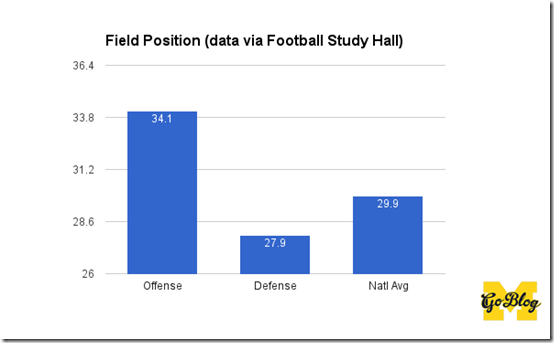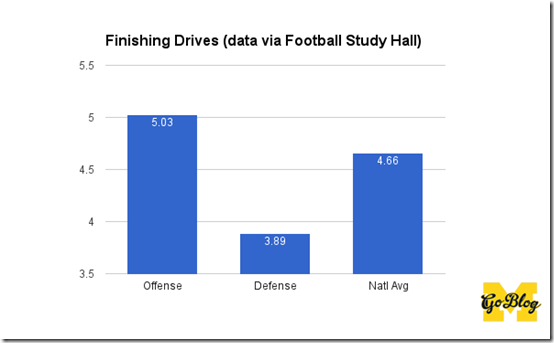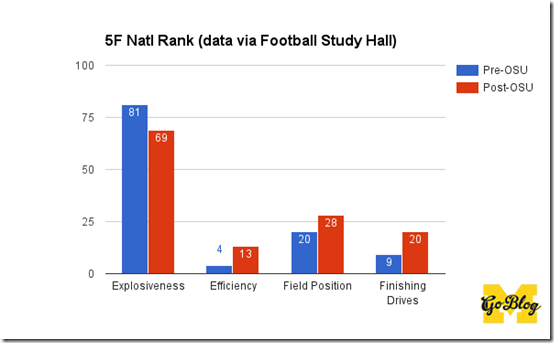Moving the (Stati)Sticks: Week 13

Looking at a 0% win expectancy might not cause you to slam your laptop shut in frustration if you’re thinking of it purely in terms of wins and losses, where a win would be 100% and a loss would be 0%. Unfortunately for all of us, that’s not how this stat works. You might want to pick your coffee cup up off your desk before you read Bill Connelly’s definition:
It is intended to say "Given your success rates, big plays, field position components, turnovers, etc., you could have expected to win this game X% of the time."
Before you put your mug back down, Michigan only had a win expectancy under 50% once, and that came against Minnesota. Also, their predicted win expectancy heading into The Game was 61%. The only silver lining is that this could be the game that killed the Dumb and Dumber “So you’re telling me there’s a chance” meme. No, Lloyd, there was not. There was literally no chance in a game that S&P+ projected Michigan to win by almost five points.
[After THE JUMP: Mathlete’s Four Factors, some depressing numbers, and some colorful charts to distract from said depressing numbers]
The Mathlete’s Four Factors:
Again, a quick reminder of what the factors mean:
Field Position = Expected team points based on starting field position. This accounts for all elements of field position: turnovers, special teams, drive penetration etc.
Conversion rate = [1st Downs gained]/[1st Down plays (including first play of drive)]. A three and out is 0/1. A one play touchdown is 1/1. Two first downs and then a stop is 2/3, etc.
Bonus Yards = [Yards gained beyond the first down line]/[Total plays from scrimmage]
This is an adjustment to how I have previously calculated, to account for the plays a team runs.
Red Zone: Points per red zone trip (TD’s counted as 7 regardless of PAT)
Offense:
| Field Pos. | Conv. Rate (%) | Bonus YPP | Red Zone | |
| Week 1 | 21.0 | 73 | 1.52 | 5.7 |
| Rank | 60 | 30 | 59 | 27 |
| Week 2 | 25.0 | 68 | 1.63 | 5.8 |
| Rank | 77 | 70 | 95 | 30 |
| Week 3 | 25.3 | 70 | 2.56 | 5.8 |
| Rank (B1G Rk) | 84 (12) | 54 (6) | 43 (6) | 30 (5) |
| Week 4 | 24.5 | 72 | 2.92 | 5.8 |
| Rank (B1G Rk) | 91 (14) | 30 (4) | 31 (3) | 27 (4) |
| Week 5 | 26.9 | 67 | 2.78 | 5.8 |
| Rank (B1G Rk) | 59 (10) | 54 (3) | 39 (3) | 20 (2) |
| Week 6 | 28.2 | 68 | 2.93 | 5.8 |
| Rank (B1G Rk) | 41 (4) | 39 (1) | 25 (2) | 21 (2) |
| Week 7 | 28.4 | 65 | 2.75 | 5.5 |
| Rank (B1G Rk) | 36 (4) | 61 (5) | 36 (3) | 31 (2) |
| Week 9 | 27.6 | 65 | 2.59 | 6.1 |
| Rank (B1G Rk) | 45 (6) | 51 (3) | 44 (6) | 3 (1) |
| Week 10 | 27.6 | 65 | 2.64 | 6.0 |
| Rank (B1G Rk) | 46 (6) | 35 (2) | 43 (5) | 4 (1) |
| Week 11 | 27.5 | 67 | 2.75 | 5.7 |
| Rank (B1G Rk) | 46 (6) | 11 (1) | 33 (3) | 13 (2) |
| Week 13 | 26.7 | 65 | 2.63 | 5.5 |
| Rank (B1G Rk) | 65 (9) | 18 (2) | 48 (4) | 22 (3) |
Defense:
| Field Pos. | Conv. Rate | Bonus YPP | Red Zone | |
| Week 1 | 27.9 | 73 | 1.64 | 5.7 |
| Rank | 47 | 44 | 20 | 30 |
| Week 2 | 25.1 | 67 | 1.60 | 6.1 |
| Rank | 51 | 58 | 23 | 88 |
| Week 3 | 24.0 | 63 | 1.28 | 6.1 |
| Rank (B1G Rk) | 35 (4) | 38 (6) | 9 (3) | 100 (13) |
| Week 4 | 23.1 | 59 | 1.23 | 6.1 |
| Rank (B1G Rk) | 29 (5) | 17 (4) | 4 (1) | 110 (13) |
| Week 5 | 24.5 | 55 | 1.10 | 6.1 |
| Rank (B1G Rk) | 32 (4) | 7 (2) | 1 (1) | 115 (13) |
| Week 6 | 23.6 | 54 | 1.01 | 6.1 |
| Rank (B1G Rk) | 21 (4) | 6 (1) | 1 (1) | 115 (12) |
| Week 7 | 23.4 | 57 | 1.24 | 6.4 |
| Rank (B1G Rk) | 20 (3) | 6 (1) | 1 (1) | 124 (13) |
| Week 9 | 23.4 | 60 | 1.54 | 4.6 |
| Rank (B1G Rk) | 17 (3) | 7 (2) | 6 (2) | 42 (6) |
| Week 10 | 24.1 | 59 | 1.61 | 4.1 |
| Rank (B1G Rk) | 22 (4) | 6 (1) | 5 (2) | 13 (2) |
| Week 11 | 24.6 | 63 | 1.64 | 4.0 |
| Rank (B1G Rk) | 27 (5) | 13 (4) | 2 (2) | 10 (2) |
| Week 13 | 24.7 | 64 | 1.84 | 4.2 |
| Rank (B1G Rk) | 24 (4) | 20 (6) | 13 (5) | 14 (2) |
*all numbers above are cumulative, not individual game data
**I’ll update this with week 12 data when I get it
The results after the Ohio State game are similar to those after the Indiana game in that the rise in most defensive metrics and the fall down the national rankings aren’t exactly unexpected. Ohio State had excellent starting field position and scored on six of their first eight drives; they punted on their first drive and ran four plays in a minute to get to the half on their fourth drive. All of this leads to a predictable rise in defensive Field Pos., which on the whole still finished a respectable 24th overall.
Defensive Conversion Rate took another tick up, and though the defense finished the year in the top half of Big Ten teams and top 20 nationally, this was one of two areas (Bonus YPP being the other) that saw significant slippage after the loss of Ryan Glasgow and general thinness of the D-line became an issue.
The offensive statistics pass the eye test as well. Having more long fields and a very poor second half driving the ball led to a drop here, and that inability to move the ball (Michigan had one second-half drive of 57 yards and no others that went for more than 22) dinged Conversion Rate and Bonus YPP as well. Red Zone points held fairly constant for both offense and defense, so the events impactful enough to move a season’s worth of data seemed to happen outside the 20 against OSU.
Advanced Box Score
Thoroughly depressing and even worse than I imagined, but if you consider the intro to this piece foreshadowing then you won’t be surprised by anything in this section. The “good,” if you want to call it that, is that Michigan ran 75 plays and gained 349 yards even though they had one less drive than Ohio State.
Moving on to the depressing stuff, which is everything else, we’ll start with Ohio State gaining 497 (!) yards at 6.9 (not nice) yards per play. They also had eight scoring opportunities to Michigan’s three and registered a good 5.25 points per trip inside the 40. (Michigan’s points per scoring opportunity was a meh 4.33.)
Starting field position, which had been one of Michigan’s strengths all season, significantly favored the Buckeyes; their average start was the 36.2, while Michigan’s was the 23.4.
Having good field position only matters if you do something with it, and you saw that Ohio State certainly did. Their Success Rate, which is basically the stat that tracks whether a team stays in favorable down-and-distance situations, was 54%; Michigan’s was just 35%.
One of the more bizarre stats in the advanced box score is turnover margin, which has illustrated Michigan’s poor turnover luck almost all season. The tables were turned against Ohio State, however, as Michigan’s actual turnover margin of –1 shows some fortune compared to their adjusted turnover margin, which was a surprising –2.12. When it rains, it pours, I guess.
Five Factors
Now that the regular season is over, I thought it made some sense to look at the offense and defense and where they stand compared to the national average.
This area showed improvement from the offense as the season wore on, and is the one area that Michigan managed to improve defensively against Ohio State. With the offense finishing above average and the defense below (lower is better in this instance), there isn’t much to worry about here. If we’re nitpicking then it would be nice to see explosiveness drop a bit more defensively, but for the majority of the season the give-up-a-55-yard-run-and-hold-15-more-carries-to-15-yards strategy worked well.
This is where the aforementioned hold-15-carries-to-15-yards thing comes into play. Michigan’s defense did an excellent job of keeping the opposition off track until the OSU game; the defense’s efficiency jumped from 31.3% before OSU to 34.5% after. Taken as a whole, the offense did a good job of picking up the necessary yardage to stay in favorable position, and the defense did a nice job derailing most opponents.
As I mentioned earlier, this was an area that Michigan performed well in almost all year. If case you haven’t noticed, Brian updated his twitter bio to include Blake O’Neill as current overlord of the universe so thanks, Blake.
Oh look, there’s a pattern emerging for how an offense and defense performs if a team is to win nine games. Again, Michigan’s offense was above average, and the defense that had been so successful all year still posted a very nice aggregate number despite last weekend’s struggle. Credit where credit’s due; that’s still a really nice defensive number.
Michigan’s offense didn’t change much in terms of national ranking of the five factors (turnover margin is excluded here because it’s not a stat with an offensive and defensive component) before and after the Ohio State game, but the defense certainly did. Michigan didn’t give up a long run, but they gave up back-breakingly consistent runs that bumped Michigan’s efficiency up and caused a subsequent fall in national rankings. The defense did give up a couple of moderately long passes, but you can see from how the national rank moved that those were not what led to Saturday’s poor showing.
Opponent’s Run Game: Michigan’s Rushing S&P+ rebounded from 15th to 9th after Penn State, and then…that. Rushing Success Rate had been top-five pretty much all year, and then they gave up beaucoup yards to a team that wanted simply took what was given to them. Michigan also saw big drops down the national rankings in Opportunity Rate, which measures how often an O-line gets five yards for the runner, and Power Success Rate, which measures how often a run results in a first down or TD when it’s third- or fourth-and-two or shorter; Opportunity Rate rose from 30.7% to 33.4%, while Power Success Rate jumped from 62.5% to 70.0%. The D-line, which was often put in less than stellar position with three down linemen, wasn’t able to do what it had so frequently throughout the season and stop runners in backfield; their national rank dropped as Stuff Rate fell from 24.2% to 22.4%.
Michigan’s Run Game: Not a great day once again. They dropped from 51/49/85 (Rushing S&P+/Success Rate/IsoPPP) to 63/58/85. Sometimes stats pass the eye test without raising an eyebrow for better or worse; this is one of those times.
Opponent’s Pass Game: Nothing too surprising here, as they passed 15 times and only picked up four passing first downs. The Passing S&P+/Success Rate/IsoPPP splits (in terms of national ranking) went from 11/8/35 to 9/11/33.
Michigan’s Pass Game: Slightly more surprising is Michigan’s movement in passing S&P stats; Michigan passed for over 300 yards, but they did throw 47 times to get there. Passing S&P+/Success Rate/IsoPPP national rankings went from 22/20/45 before Ohio State to 15/21/49 after. The increase in overall Passing S&P+ despite a drop in Success Rate and IsoPPP is interesting and, frankly, something I can’t really explain, but hey, let’s close on a nice if somewhat inconsequential note.
But what about FEI?
Heh, almost looked like we really were going to close on a good note for a minute. This is something I plan on tracking more closely next season, but what I can tell you is that while the offense showed improvement (rising from 39th to 35th) the defense dropped quite a bit (seventh to 19th), which dragged Michigan way outside the top ten, where they had resided at the very least since FEI throws out past performance indicators in week seven; Michigan was tenth heading into the OSU game and ends the regular season as the 22nd best team in FEI’s cold, unfeeling, binary lovin’ eyes.
December 4th, 2015 at 11:23 AM ^
I imagine this was as painful to write as it was to read.
December 4th, 2015 at 11:26 AM ^
Not the loss, but the post-game analysis.
In hindsight, the way each side played, the two teams could play 100 re-matches and we'd lose 100 times. Mind you there were a lot of breakdowns. What-ifs about D-line injuries aside (we're looking at the teams as they stood Saturday morning), the linebackers had a bad day, our QB got injured, and while I was a staunch defender of Durkin's strategy in the first half, in light of recent news it may be that he was running that game with a "last day at the office" mentality, hence the lack of halftime adjustments. But to win you need to out-play your opponent, and none of those are enough to overcome the difference.
December 4th, 2015 at 11:49 AM ^
Sent from MGoBlog HD for iPhone & iPad
December 4th, 2015 at 3:45 PM ^
Sorry about that, I usually try and link them somewhere in the piece but forgot to this time. Here are a couple of pieces that are as good a place to start as any:
Football Study Hall's Adv Stats Glossary
And if you're looking for a some extra reading:
Football Outsiders' Adv Stats Glossary
I'm going to round up all the links I think are helpful and put them in a header on these posts next season.
December 4th, 2015 at 12:18 PM ^
Sent from MGoBlog HD for iPhone & iPad






Comments